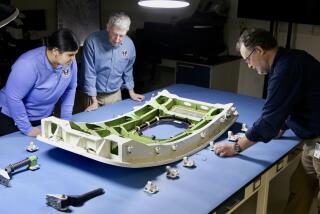Metallurgist to Study Part of Stabilizer
PORT HUENEME — A metals expert arrived at the Port Hueneme naval base Wednesday to assist federal officials with their investigation of last week’s crash of Alaska Airlines Flight 261.
Metallurgists are a regular part of crash investigations, and use their expertise in steel, aluminum and other metals, which comprise fuselage and specific components, to help explain what might have contributed to a crash, officials said.
In the Alaska Airlines crash in the waters near Anacapa Island, which killed all 88 passengers and crew, the National Transportation Safety Board metallurgist will be focusing on Flight 261’s damaged jackscrew, a 2-foot-long component of the plane’s horizontal stabilizer, said NTSB spokesman Terry Williams.
In the final minutes of Flight 261 on Jan. 31, the pilots reported having trouble controlling the plane because of problems with the stabilizer--a wing-like mechanism on the plane’s tail that controls the up-and-down pitch of the nose.
The stabilizer’s damaged jackscrew was recovered from the sea floor near Anacapa Island on Tuesday night and taken to a storage facility at Port Hueneme. Investigators hope to determine whether the jackscrew was damaged during flight or on impact.
Robert O. Ritchie, a professor of materials science at UC Berkeley who has worked as an expert in litigation over airplane crashes, said metallurgists follow a standard procedure in such investigations.
During their analysis, they scan components for fractures and conduct a chemical analysis to determine if the part in question was defective or made from substandard materials, Ritchie said.
In identifying a fracture, “you want to look and see whether it broke and caused the failure, or whether it broke because of the failure,” he said. A break that caused a plane’s failure might manifest itself through a series of fissures, whereas a break caused by the crash would more likely appear as a clean, single break, he said.
The information the NTSB metallurgist gleans from his examination of the stabilizer jackscrew may be helpful in determining what went wrong with Flight 261. Moreover, it may help determine who is to blame. In any case, the findings could be an integral part of litigation in the months to come, Ritchie said.
In other developments, nine of the passengers have now been identified, three by dental records, three by fingerprints and three by tattoos, according to the Ventura County medical examiner’s office.
The names of all the persons identified will be released after family members have been notified, officials said.
Meanwhile, the Navy on Wednesday held a brief service for relief workers from various government agencies.
Ann Sobel, executive director of the Ventura County chapter of the American Red Cross, who helped coordinate the private service, said many relief workers have been traumatized by the grisly recovery tasks. She said the feelings are probably more acute now that most of the recovery has been completed, and the workers have returned to their normal routines.
“Their lives were significantly impacted, and for most of them, that kind of disaster was a first-time event,” Sobel said.
The 70 or so employees who attended the service in the Seabees chapel at the Naval Construction Battalion Center were thanked for their assistance, Sobel said. They were also told by the chaplain leading the service not to hide their emotions about the event.
Candles were lighted in honor of the agencies that assisted, including the U.S. Coast Guard, the Navy, and the county’s sheriff’s, fire and emergency services departments, while a naval officer sang “Amazing Grace,” Sobel said.
* JET INSPECTION
Alaska and American Airlines begin checking horizontal stabilizers. A1
More to Read
Sign up for Essential California
The most important California stories and recommendations in your inbox every morning.
You may occasionally receive promotional content from the Los Angeles Times.











